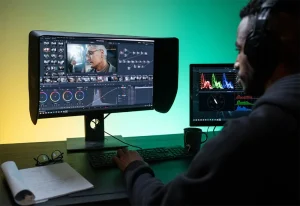Turn ordinary elements into stunning visuals by mastering the art of pre-production, honing camera techniques, and embracing editing magic. Start with a clear concept and storyboard, then use creative camera angles and lighting. Boost your visuals with advanced editing techniques like color grading and smooth transitions. Collaborate with your team to optimize workflow and stay updated with design trends. Discover how automation enhances creativity, and uncover inspiration through professional design communities for more insights.
Embracing the Power of Pre-Production
Before diving into the creative process, you must embrace the power of pre-production as it lays the groundwork for stunning visuals. Start by clearly defining your concept and objectives. Knowing your purpose will guide every decision you make. Create a detailed storyboard to visualize the narrative flow, ensuring everyone involved understands your vision. Don’t skip location scouting; it’s vital for choosing settings that complement your theme. Additionally, organize your equipment and ensure everything is in working order to avoid last-minute hiccups. Collaborate with your team, assigning roles and responsibilities so everyone’s on the same page. Effective communication is key. By meticulously planning each step, you’ll streamline production, reduce stress, and set the stage for breathtaking visuals that captivate your audience.
Crafting the Perfect Shot: Camera Techniques and Tips
Capturing the perfect shot requires a keen understanding of camera techniques and an eye for detail. Start by mastering the exposure triangle: aperture, shutter speed, and ISO. Knowing how to balance these settings will help you control light and depth of field effectively. Don’t forget about composition; use the rule of thirds to create a balanced image that draws the viewer in.
To elevate your photography skills, consider these essential tips:
- Experiment with Angles: Don’t just shoot from eye level. Explore high and low angles for dynamic perspectives.
- Utilize Natural Light****: Early morning and late afternoon offer soft, flattering light that enhances your subject.
- Stabilize Your Camera: Use a tripod or a steady hand to avoid blurriness, ensuring sharp, clear images.
These techniques will enhance your visual storytelling.
Editing Magic: Turning Footage Into Art
Transforming your footage into a work of art starts with mastering color grading techniques that bring your visuals to life. By using seamless transition effects, you can create a smooth and engaging narrative flow that captivates your audience. Embrace these editing tools to elevate your storytelling and make your videos truly unforgettable.
Color Grading Techniques
When you dive into the world of color grading, you unlock the potential to transform ordinary footage into captivating art. This process allows you to set the mood, evoke emotions, and bring your creative vision to life. With a few techniques, you can drastically change the look and feel of your visuals.
- Balance Colors: Adjust the white balance to ensure your colors appear natural and consistent across all scenes.
- Enhance Saturation: Boost or mute colors to emphasize specific elements and guide the viewer’s attention.
- Apply Color LUTs: Use Look-Up Tables (LUTs) to quickly apply professional-grade color styles, adding depth and style to your footage.
Seamless Transition Effects
While mastering the art of editing, seamless transition effects can elevate your footage from basic to breathtaking. You’ll find that transitions are more than just passing from one scene to another; they’re about creating a visual flow that captivates your audience. Start by choosing the right transition for your narrative—think about the mood and pacing of your project.
Use techniques like cross-dissolves for softening cuts, or whip pans for dynamic movement. Pay attention to timing; matching transitions with music beats can add rhythm and energy. Don’t overuse them, though. A well-placed transition should feel natural and intentional, enhancing rather than distracting from your story. With practice, you’ll turn your edits into a seamless, artistic journey that keeps viewers engaged from start to finish.
Enhancing With Effects: Adding Depth and Dimension
You’re about to unlock the secrets of transforming flat visuals into captivating masterpieces by mastering layering techniques. By applying color grading, you can evoke emotions and guide the viewer’s eye with subtle shifts in tone and hue. Don’t forget to add texture, which enhances depth and creates a tactile dimension that draws audiences in.
Layering Techniques Explained
Although mastering layering techniques might initially seem daunting, they’re essential for adding depth and dimension to your visuals. With each layer, you can introduce new elements, blend textures, and create a stunningly complex image. Start by organizing your layers effectively. This approach allows you to control each element independently, making adjustments without affecting the whole composition.
Consider these key layering techniques:
- Blend Modes: Experiment with different blend modes to seamlessly integrate layers, enhancing contrast and texture.
- Opacity Adjustments: Alter layer opacity for subtle transitions and to emphasize depth.
- Layer Masks: Use masks to hide or reveal parts of a layer, providing precision in your edits.
Color Grading Magic
Color grading transforms your visuals by adding mood and atmosphere, making it an essential tool in your creative arsenal. It helps you shape the story you’re telling, enhancing emotions and drawing viewers in. By tweaking hues, contrasts, and saturation, you can turn a flat image into a captivating scene.
Start by identifying the emotion you want to convey. Do you want warmth, mystery, or drama? Adjust the color temperature to match your vision. Brighten highlights for vibrancy or deepen shadows for intensity. Using color wheels, you can fine-tune every shade to perfection.
Don’t forget about secondary color corrections. Isolating and enhancing specific colors can guide the viewer’s eye and emphasize key elements. With practice, your color grading skills will bring any project to life.
Texture Integration Tips
When you integrate textures into your visuals, you add a layer of depth and dimension that can transform an ordinary image into something truly compelling. To make the most of texture integration, it’s important to choose textures that complement your subject and enhance your story. Don’t be afraid to experiment with different blending modes to see how they interact with your base image. Here are some quick tips to elevate your designs:
- Layer Strategically: Use multiple textures in layers to create a rich, complex look.
- Adjust Opacity: Tweak the opacity to ensure the texture doesn’t overpower the main elements of your design.
- Blend Creatively: Try different blending modes, such as Overlay or Soft Light, to achieve the desired effect.
Use these tips to bring your visuals to life!
Collaborating for Success: The Role of Teamwork
Collaboration is the keystone of any successful creative endeavor, especially when crafting stunning visuals. When you bring together a diverse team, each person’s unique strengths and perspectives contribute to the final masterpiece. Open communication is crucial. Share ideas freely, listen actively, and encourage feedback. This fosters an environment where creativity thrives.
Assign roles based on individual skills and expertise. This ensures efficiency and allows each team member to shine in their respective areas. Use collaborative tools to streamline the workflow and keep everyone on the same page. Regular check-ins and brainstorming sessions help maintain momentum and address any challenges.
Staying Ahead: Embracing New Tools and Trends
To stay ahead in the ever-evolving landscape of visual design, you must embrace both new tools and emerging trends. Adopting cutting-edge technologies can significantly enhance your creative process and keep your visuals fresh and engaging. Here’s how you can stay on top:
- Explore AI-driven design software****: These tools can automate mundane tasks, allowing you to focus on creativity.
- Stay updated with design trend reports****: Regularly reviewing these reports helps you anticipate what will captivate audiences.
- Join design communities****: Engage with other professionals to exchange insights and discover novel approaches.
Frequently Asked Questions
What Are the Best Practices for Securing Client Approval During the Creative Process?
You should communicate clearly and regularly with clients, setting expectations upfront. Present drafts early, seek feedback, and make necessary revisions. Always align creative ideas with their vision to ensure they feel included and valued in the process.
How Do You Handle Unexpected Challenges During a Shoot?
When you face unexpected challenges during a shoot, stay calm and adaptable. Communicate with your team, brainstorm solutions, and have backup plans ready. Embrace improvisation, and view challenges as opportunities to showcase your creativity and problem-solving skills.
What Strategies Are Used for Maintaining Consistency Across Different Projects?
You ensure consistency by creating detailed style guides, setting clear communication channels, and using standardized editing processes. Regularly review your work against benchmarks and gather feedback to align your team’s vision across various projects.
How Do You Ensure Efficient Communication Between Remote Team Members?
You ensure efficient communication by leveraging collaboration tools like Slack or Zoom. Set clear expectations and regular check-ins. Foster an open environment where everyone feels comfortable sharing ideas and updates. Stay organized with shared documents and calendars.
What Steps Are Taken to Protect Intellectual Property in Visual Projects?
When protecting intellectual property in visual projects, you should use watermarks, secure file sharing systems, and NDAs. Always educate your team on copyright laws and ensure project files are stored in encrypted and access-controlled environments.


